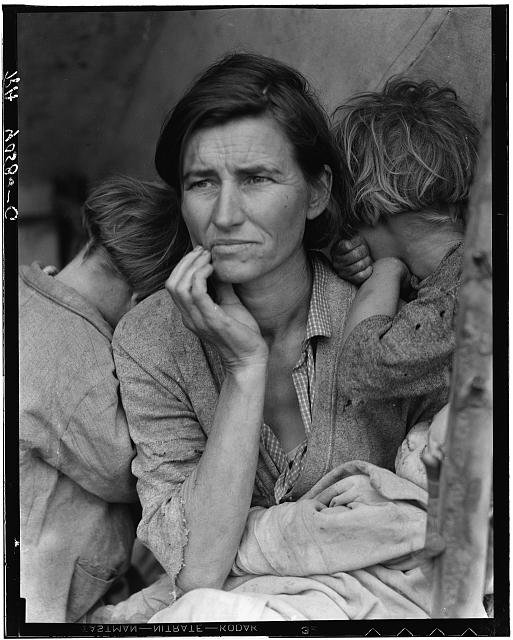Teach This Poem is a weekly series featuring a poem from our online poetry collection, accompanied by interdisciplinary resources and activities designed to help K–12 teachers quickly and easily bring poetry into the classroom.
Note: Click the "<>" icon to see the poem in expanded view.

“Destitute pea pickers in California. Mother of seven children. Age thirty-two. Nipomo, California.” Library of Congress Prints and Photographs Division Washington, D.C.
The following activities and questions are designed to help your students use their noticing skills to move through the poem and develop their thinking about its meaning with confidence, using what they’ve noticed as evidence for their interpretations. Read more about the framework upon which these activities are based.
- Warm-up (pair share): Take turns making a gesture with your upper body that shows a strong feeling. (Remember that it must be appropriate for school.) What emotion does your partner’s gesture suggest to you and why?
- Before Reading the Poem (individual writing): What details do you notice in the photograph by Dorothea Lange? How are the people in the photograph positioned? What can you learn from the positions of their bodies and the expression on the woman’s face?
- Small-group Discussion: Share what you’ve noticed and learned with the members of your group. Compile a list of what you noticed to share later.
- Reading the Poem: Read the poem silently. Write down the words, phrases, and structures that jump out at you.
- Listening to the Poem (enlist two volunteers to read the poem aloud): Listen as the poem is read aloud twice. Write down any additional words and phrases that jump out at you.
- Small-group Discussion: What words, phrases, and structures did you notice in the poem? How does the poem relate to the warm-up activity and to the photograph? What do you notice about the poem’s structure?
- Whole-class Discussion: What do you think the poem is saying about the importance of body language? In what context is the poem’s speaker noticing someone’s body language? Why, or why not, do you think this is important?
- Extension for Grades 7-10 (small-group activity): Create tableaux staging either a genuine or a pretend apology. (Keep the type of apology you’re working on a secret from the other groups.) Take turns presenting your tableaux to the whole class. As each group presents, share the details you noticed and what type of apology you thought the group was portraying.
- Extension for Grades 11-12: Read the joint resolution to “offer an apology to all Native Peoples,” which was introduced in the United States Senate on April 30, 2009. What word do you notice repeated throughout the apology? (Review its definition if you’re not familiar with the different uses of this word.) How does this apology inform your reading of Layli Long Soldier’s poem (which is the beginning of a longer series)?
Read more poems about social justice.
More Context for Teachers: This poem is from Layli Long Soldier’s book WHEREAS (Graywolf Press, 2017). Read a sample of other poems from the book, along with a brief review by the poet Jennifer Michael Hecht, who writes, “[Long Soldier’s] vision is intense and incisive. Many of these poems report on rage and the toll of having to carry it around.” Read more.
